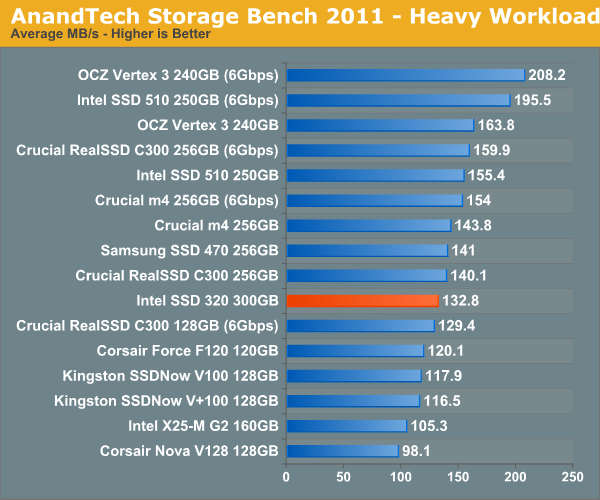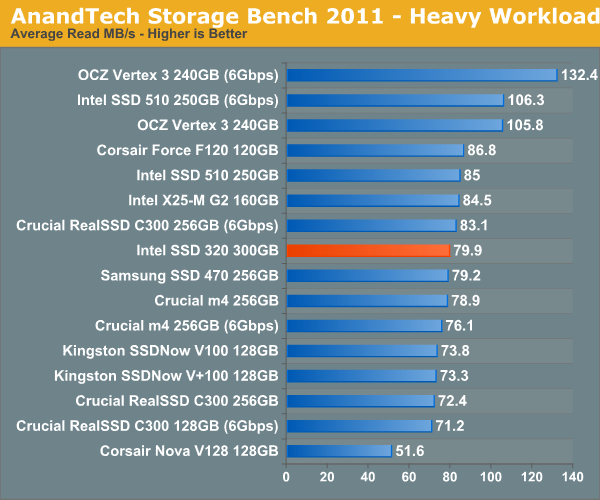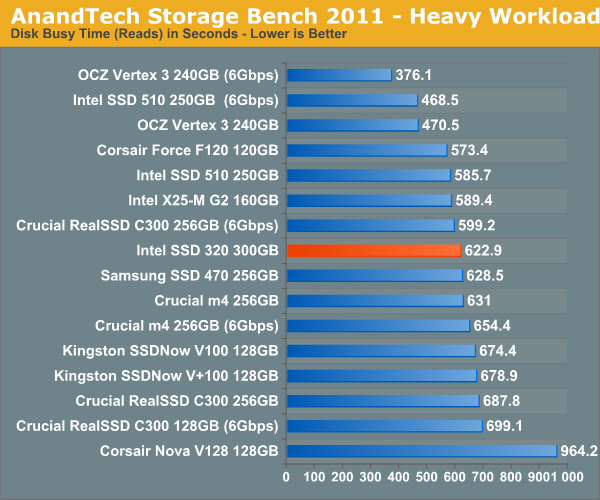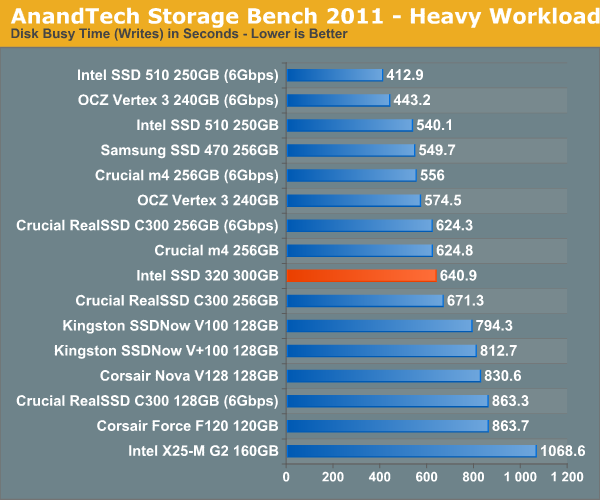The Intel SSD 320 Review: 25nm G3 is Finally Here
by Anand Lal Shimpi on March 28, 2011 11:08 AM EST- Posted in
- IT Computing
- Storage
- SSDs
- Intel
- Intel SSD 320
AnandTech Storage Bench 2011: Much Heavier
I didn't expect to have to debut this so soon, but I've been working on updated benchmarks for 2011. Last year we introduced our AnandTech Storage Bench, a suite of benchmarks that took traces of real OS/application usage and played them back in a repeatable manner. I assembled the traces myself out of frustration with the majority of what we have today in terms of SSD benchmarks.
Although the AnandTech Storage Bench tests did a good job of characterizing SSD performance, they weren't stressful enough. All of the tests performed less than 10GB of reads/writes and typically involved only 4GB of writes specifically. That's not even enough exceed the spare area on most SSDs. Most canned SSD benchmarks don't even come close to writing a single gigabyte of data, but that doesn't mean that simply writing 4GB is acceptable.
Originally I kept the benchmarks short enough that they wouldn't be a burden to run (~30 minutes) but long enough that they were representative of what a power user might do with their system.
Not too long ago I tweeted that I had created what I referred to as the Mother of All SSD Benchmarks (MOASB). Rather than only writing 4GB of data to the drive, this benchmark writes 106.32GB. It's the load you'd put on a drive after nearly two weeks of constant usage. And it takes a *long* time to run.
I'll be sharing the full details of the benchmark in some upcoming SSD articles but here are some details:
1) The MOASB, officially called AnandTech Storage Bench 2011 - Heavy Workload, mainly focuses on the times when your I/O activity is the highest. There is a lot of downloading and application installing that happens during the course of this test. My thinking was that it's during application installs, file copies, downloading and multitasking with all of this that you can really notice performance differences between drives.
2) I tried to cover as many bases as possible with the software I incorporated into this test. There's a lot of photo editing in Photoshop, HTML editing in Dreamweaver, web browsing, game playing/level loading (Starcraft II & WoW are both a part of the test) as well as general use stuff (application installing, virus scanning). I included a large amount of email downloading, document creation and editing as well. To top it all off I even use Visual Studio 2008 to build Chromium during the test.
Many of you have asked for a better way to really characterize performance. Simply looking at IOPS doesn't really say much. As a result I'm going to be presenting Storage Bench 2011 data in a slightly different way. We'll have performance represented as Average MB/s, with higher numbers being better. At the same time I'll be reporting how long the SSD was busy while running this test. These disk busy graphs will show you exactly how much time was shaved off by using a faster drive vs. a slower one during the course of this test. Finally, I will also break out performance into reads, writes and combined. The reason I do this is to help balance out the fact that this test is unusually write intensive, which can often hide the benefits of a drive with good read performance.
There's also a new light workload for 2011. This is a far more reasonable, typical every day use case benchmark. Lots of web browsing, photo editing (but with a greater focus on photo consumption), video playback as well as some application installs and gaming. This test isn't nearly as write intensive as the MOASB but it's still multiple times more write intensive than what we were running last year.
As always I don't believe that these two benchmarks alone are enough to characterize the performance of a drive, but hopefully along with the rest of our tests they will help provide a better idea.
The testbed for Storage Bench 2011 has changed as well. We're now using a Sandy Bridge platform with full 6Gbps support for these tests. All of the older tests are still run on our X58 platform.
AnandTech Storage Bench 2011 - Heavy Workload
We'll start out by looking at average data rate throughout our new heavy workload test:

Overall performance is decidedly last generation. The 320 is within striking distance of the 510 but is slower overall in our heavy workload test.
The breakdown of reads vs. writes tells us more of what's going on:


The next three charts just represent the same data, but in a different manner. Instead of looking at average data rate, we're looking at how long the disk was busy for during this entire test. Note that disk busy time excludes any and all idles, this is just how long the SSD was busy doing something:













194 Comments
View All Comments
anthonyjcho - Thursday, November 17, 2011 - link
I just got the 40GB version of this drive for my work computer as a cache drive.I have a large DB files (1-2GB) that I access frequently and I needed a "reliable" SSD for my task. Crucial and Intel came to mind, and only Intel products could be sourced. By the way, I use a OCZ SSD at home for gaming for better read performance.
Long story short,
100-105 MB/s for Read/Write is drastic improvement over the 7200rpm HDD I was using.
My work is much more productive because I don't have to wait so long for data retrieval anymore.
I highly recommend it to any data analyst.
spacehead74 - Thursday, January 5, 2012 - link
I've been finding these on Ebay for less than $200/160gb. The 5-year warranty is a great selling point when using these for laptop upgrades.sqeeek - Thursday, October 2, 2014 - link
Still using two of these as of October 2014. Not the fastest sequential r/w but the random reads + low latency are still mind-blowingly fast compared to a spinning disk. Reliability is great as well - I even bought one used.DocSportello - Monday, September 21, 2015 - link
I installed my 320 in early 2012, and it's still running strong. My first (and thus far only) SSD, so it was a huge step up from HDs.If the numbers I saw at the time were to be believed, 320's were significantly more reliable than the alternatives. I got a bit spooked by those ongoing reports of 8-megabyte crashes; was it just a matter of time until that happened to me? But those reports mostly involved a system crash and usually a power loss; that's rare for me on a desktop with a quality power supply and a UPS.
Anyway, for whatever reason, my 320 is doing well. The specs claimed a million hours MTBF; what did the real numbers turn out to be? Oddly, the SSD Toolbox shows less than a thousand hours of power-on time, which would be unbelievably low, except I saw a post somewhere suggesting that that number is more a count of read/write activity than powered on and ready.
If I were buying today, I'd look at a Samsung 850, figuring the 40 nm cells have got to be inherently more robust than today's typical 19 nm cells. But that's theory; meanwhile the Intel 320 keeps rolling along.